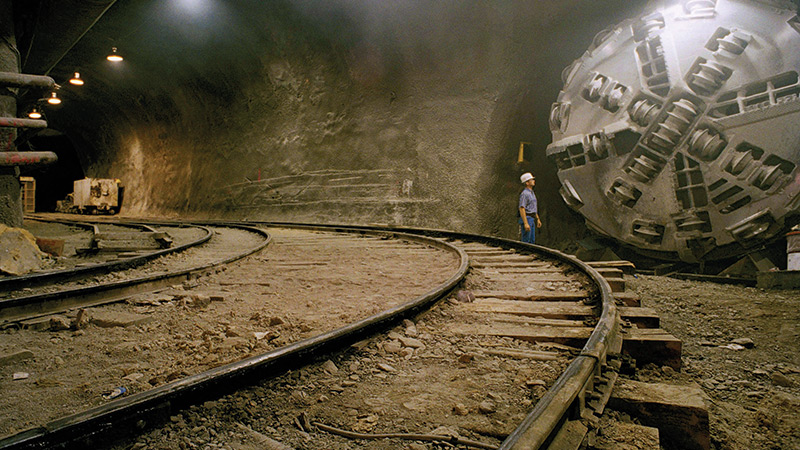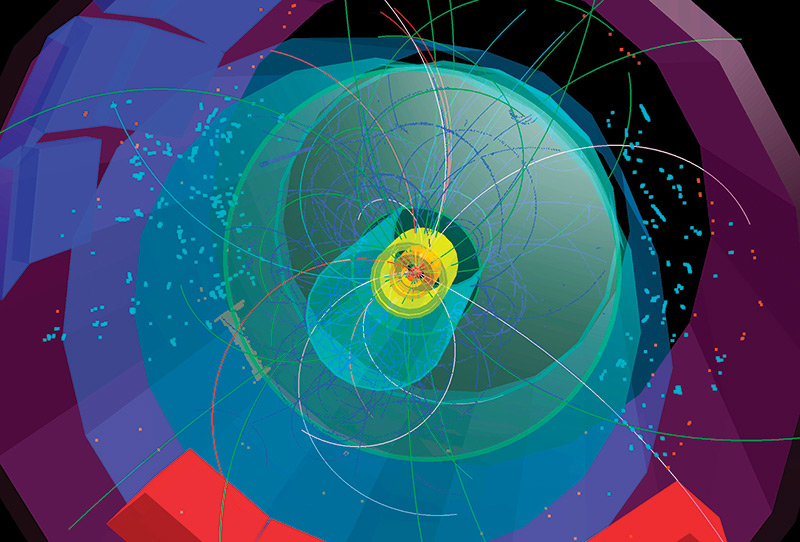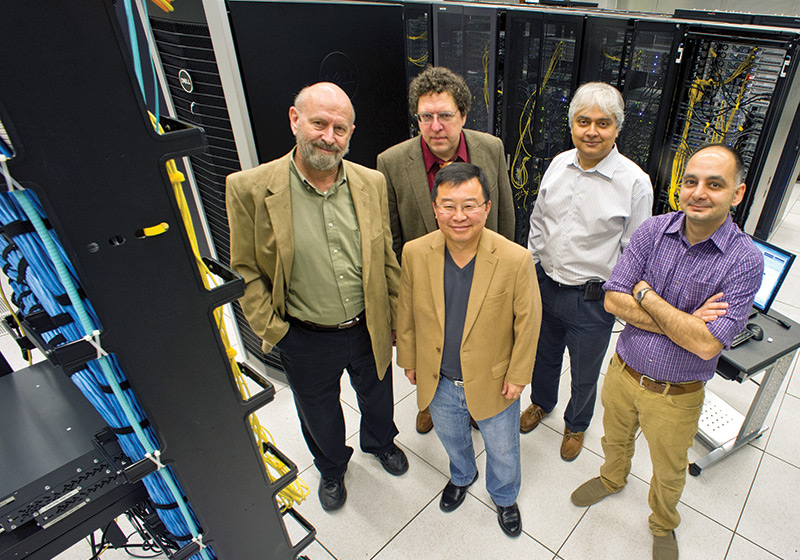Just outside of Geneva, Switzerland, a massive, 17-mile stretch of tunnels and tubes rumbles beneath the winding streets. Called the Large Hadron Collider, it is the most powerful particle accelerator in the world and the single largest machine in existence. Millions of times a second, beams of subatomic particles are shot near the speed of light through the tunnels and smashed into each other, as scientists try to solve some of life’s biggest mysteries.
It was here in 2012 that two teams of scientists discovered the long-elusive Higgs boson, an invisible force-field that permeates space and endows particles with mass. Without the Higgs, there could be no stars, no planets, no life. Unsurprisingly, the discovery was rewarded with a Nobel Prize.
Though located about 5,000 miles southwest of the Large Hadron Collider site, UT Arlington played a key role in this remarkable discovery. Members of the University’s Center of Excellence in High Energy Physics have spent the past two decades hunting for the Higgs as part of a larger experiment known as ATLAS.
“The importance of finding the Higgs boson cannot be overstated,” says Kaushik De, physics professor and director of the center. “This was one of the most important scientific discoveries in our lifetime. It was a game-changer, and UT Arlington played a central role in it.”
Today, the University’s team of elite scientists continues to forge a prominent role in the field of high-energy physics, both in the further study of the Higgs boson and in the hunt for new particles, particularly dark matter, the invisible substance that makes up more than a quarter of the universe.
Researchers are developing new detectors, creating innovative software to help physicists study collisions, and leading efforts to build a new international collider. Through their ongoing research, they hope to eventually solve some of the many unanswered questions in high-energy physics, like why is the universe made of matter instead of anti-matter? Are we living in a supersymmetrical universe or a chaotic one? Why is gravity so weak compared to the other universal forces?
“There are so many discoveries that could help us understand the origins of the universe,” physics Professor Jaehoon Yu says. “The Higgs was just the beginning.”
Collider Do-Over
Rolling prairieland blankets Waxahachie, Texas, a small town 50 miles southeast of Arlington. In the late-1980s, development began there on an enormous particle accelerator known as the Superconducting Super Collider.
With a circumference of 54 miles, it was intended to be the world’s largest particle accelerator, and it drew scientists from around the world to North Texas. In anticipation of its opening, UT Arlington began recruiting top physicists—such as Dr. De, who arrived in 1993—to conduct research in high-energy physics.

A precursor to the LHC, the Superconducting Super Collider was scrapped by Congress in 1993.
But the Superconducting Super Collider was never finished. In October 1993, after $2 billion had been spent and 14.6 miles of tunnel dug, Congress killed the project amid budget worries.
Fifteen years later, the European Organization for Nuclear Research—or CERN—launched the Large Hadron Collider and began hunting for the Higgs. A handful of physicists at UT Arlington joined the effort, collaborating with scientists at CERN and at the Fermi National Accelerator Laboratory in Illinois.
Today, the Center of Excellence in High Energy Physics has grown to eight professors and dozens of undergraduate and graduate students. Each year, the team generates millions of dollars in research grants and pens hundreds of scientific papers. In fact, 15 of the authors on the published Higgs boson paper came from UT Arlington. Currently, 25 researchers from the University work on ATLAS, splitting their time between Arlington and Geneva.
Proving the Big Bang
Described as a sort of cosmic molasses, the Higgs boson is named for Peter Higgs, who along with a handful of other scientists theorized its existence in 1964. Particles, physicists believed, would get their mass from interacting with this invisible force-field that swirls through the universe.
To prove the theory, scientists planned and built the Large Hadron Collider, which serves as a sort of circular racetrack for particles. Directed by magnets, protons zip around the tunnels before crashing into each other, thus generating a shower of other subatomic particles. One of these particles, scientists long hoped, would be the Higgs boson, popularly known as the “God particle.”
“Essentially, the accelerator re-creates the same conditions that occurred shortly after the Big Bang,” physics Professor Andrew Brandt explains. “The collisions give us the opportunity to study how the universe evolved nearly 14 billion years ago.”
Because the particles instantly begin to decay, researchers must wade through the shower for any deviations that point to new particles. Enormous detectors capture and record each collision.
One such detector arrived at CERN in 62 crates, each weighing nearly a ton. Resembling a large wheel, the Intermediate Tile Calorimeter—which was conceived, designed, and built by physicists at UT Arlington—measures energy before and after the protons collide, providing information crucial for discovering new particles.

Particle tracks from collisions within the LHC provide key data for scientists.
“Think of ATLAS as an enormous, extremely high-tech camera,” says De, who oversees U.S. computing operations for the experiment. “Each collision provides us with a very complex, 3-D picture. When the protons collide, energy goes missing. Understanding that missing energy is key to understanding the big picture.”
More upgrades to the Large Hadron Collider are underway. Dr. Brandt is leading a team that is developing a sub-detector that could significantly boost ATLAS’ measurement capabilities. Made of synthetic quartz and a specialized photomultiplier tube, the detector would measure the time-of-flight of protons scattered at small angles. The tube, consisting of two compact lead glass plates perforated with small holes, converts small amounts of light into electrical signals that can be measured. Experiments have demonstrated that it provides a 20-fold increase in device lifetime than what is currently used.
“Although our original motivation was to upgrade the LHC, this device could become a staple of high-energy physics experiments,” Brandt says. “It also has potential for homeland security and night-vision applications.”
A System of Supercomputers
The search for the Higgs boson, and now for new particles, generates a massive amount of information, more than 40 million pieces of data every second. But even CERN lacks the computing capacity to process such volumes. Instead, information flows to about 100 supercomputing centers across the world, including the Southwest Tier 2 Center at UT Arlington.
To harness their combined power and process the ATLAS data, UT Arlington and the Brookhaven National Laboratory in New York collaborated to develop PanDA, a workload management system that seamlessly connects all the centers.
“We realized very quickly that computing power would be key to the success of ATLAS, and that kind of computing power was not available anywhere in the world,” says De, who led the software development. “So we thought, ‘Let’s take supercomputers from around the world and link them together to work as one giant supercomputer.’”
UT Arlington and Brookhaven, a research institution funded primarily by the U.S. Department of Energy, are now developing a universal version of the software that could be used in biomedicine and astrophysics, among other fields.
“PanDA has been extremely useful in boosting our computing power in ways that were not possible just a few years ago,” De says. “We could not have found the Higgs without it.”
Helping Computers Communicate
At the same time, the Southwest Tier 2 Center is preparing to receive a big boost in connectivity, thanks to a $500,000 grant from the National Science Foundation.
Networking capacity will be 10 times faster across the UT Arlington campus for researchers who use massive amounts of data. This upgrade not only will aid high-energy physics discoveries, but also projects in science and engineering, including those trying to link chronic diseases with features of the human genome and those using data collection to build better civil infrastructure.
For the field of high-energy physics, the timing of the upgrade is key, as scientists at CERN are beginning to increase the energy of collisions to search for dark matter and other new phenomena.
“Computing is one of the pillars on which high-energy physics experiments are built,” Associate Professor Amir Farbin says. “Yet it can be an overlooked aspect of it.”
Dr. Farbin, who develops the software physicists use to analyze the data from CERN, is exploring the potential for deep-learning methods to advance high-energy physics. Deep learning, in which computers learn automatically, is a branch of computer science that uses large, artificial neural networks to process data. (Facebook, for example, uses the technology to identify friends in users’ photographs.)
“For now, physicists develop mathematical formulas and algorithms that they feed to computers, which then search for new or exotic particles,” Farbin explains. “But what if our machines could instead create the formulas, eliminating that time-consuming task for us?”
Constructing a New Collider
Such computing advances not only would boost the capabilities of the Large Hadron Collider, but also the proposed International Linear Collider, or ILC. Construction could begin as early as 2019 on the new, 19-mile machine, tentatively planned for installation in Japan.

From left:Andrew White, Andrew Brandt, Jaehoon Yu, Kaushik De, and Amir Farbin.
“The International Linear Collider will help us solve the missing pieces of the puzzle and advance our understanding of the universe and how it works,” says physics Professor Andrew White, who is helping guide its design and development. “This will complement and bolster the work being done at the Large Hadron Collider.”
The two colliders, however, will differ in a key way: While the Large Hadron Collider smashes protons together, the ILC will smash electrons and their anti-particles, positrons. That should result in more precise measurements. Each second, 14,000 collisions will be captured and recorded for analysis.
“Colliding protons can be very messy. It creates a great shower of particles,” says Dr. White, who also serves as spokesman for one of the two detectors that will be based at the ILC. “The International Linear Collider will allow us to crash smaller elementary particles, which will give us a more accurate picture and unprecedented scientific precision.”
Initially, the ILC will attempt to create and investigate the Higgs boson, but the collider should also be well-suited for studying dark matter and dark energy, perhaps shedding light on issues such as Supersymmetry, the theory that predicts a partner for each particle in the Standard Model.
The Next Frontier
Only 5 percent of our universe has been observed—the rest remains a mystery. Scientists believe that dark matter makes up roughly a quarter of the remainder, serving as scaffolding and binding our stars and galaxies together.
Yet it is impossible to detect with current instruments because it does not absorb, reflect, or emit light. In fact, dark matter has only been observed through the effect of its gravity.
But that may soon change, as teams at CERN and the Fermi Laboratory turn their attention toward the invisible material.
“Rather than wait for dark matter to come to us, we are trying to create it ourselves,” physics Professor Jaehoon Yu says. “This is unexplored territory that could help us uncover paradigm-changing new physics.”
It is a challenging proposition, though, because unlike the Higgs, dark matter appears to interact weakly with visible matter, meaning it could easily pass undetected through the Large Hadron Collider. The only clue it would leave behind is its missing energy.

















